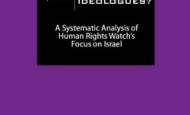Experts or Ideologues? The Middle East and North Africa (MENA) Division in Context
The references for this article are available here
The Middle East and North Africa (MENA) Division in Context
Analysis of HRW’s spending and publications reveals that the Middle East Division receives a roughly constant allocation of resources compared to other divisions, but that there is disproportionate focus on Israel within the division itself. Also, other departments such as “emergencies” contribute significantly to HRW reports on Israel. There is a graph that shows the percentage of project spending that went to various HRW departments between 1997-2007.9
The data show that spending on Asia, the Middle East, Children’s and Women’s rights remained largely constant in those ten years. Spending on “Arms” (“to curtail arms transfers”) peaked in 2002 but then fell sharply in 2006, and was no longer listed as a separate division in 2007. Spending on Africa rose marginally, while allocations to the Americas fell slightly. The focus on Europe and Central Asia (formerly Helsinki Watch) fell dramatically after 1997, reflecting the shift from a post-Cold War perspective to a more global focus. The “International Justice” division grew in significance from 2006, having previously been subsumed under “other programs.” This indicates HRW’s support for international legal mechanisms to pursue redress for human rights violations.10 The “United States” was established as a separate division in 2006, reflecting HRW’s concerted campaign against U.S. policy in Iraq, Afghanistan, and elsewhere following the attacks of 9/11. Furthermore, the growth of the “Other Programs” division, which includes counterterrorism, LGBT rights, Refugees and Business, reflects a growing recognition that many human rights are threatened by cross regional factors.

